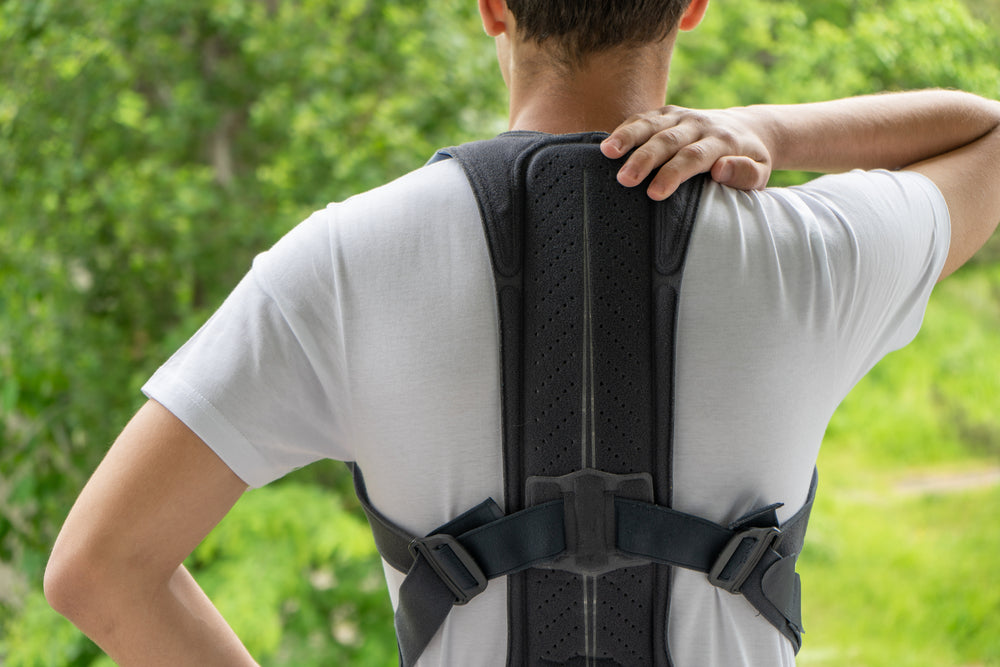Stuck on what to wear to physical therapy?
Booking a physical therapy session can be a great way to give your body the attention and care it needs to get back into shape.
This non-invasive form of health care makes use of exercises, muscle stimulation, massage therapy, and other techniques to help patients strengthen and recover from physical injuries. It's widely used to treat a variety of conditions, including arthritis, stroke, sports injuries, fractures, and joint problems.
While physical therapy can be a highly effective form of treatment, what you wear can affect how successful you are in your recovery.
Yes, you read that right—the clothes you choose to wear can make a world of difference in the quality of your therapy session and the effectiveness of treatments.
To help you make the most of your physical therapy session, we've put together this guide on what to wear to physical therapy.
We'll also provide some tips on certain clothes you should avoid to ensure a more comfortable and successful experience. Let's get started!
What to Wear to Your Physical Therapy Session
From tight-fitting clothes to loose-fitting garments, the clothes you wear to your therapy sessions play a big role in how successful your treatment can be.
Here's a list of what to wear to a physical therapy session:
Tanktop
Tank tops are a great option for physical therapy sessions.
These loose-fitting garments provide you with plenty of room to move around while still keeping you covered and comfortable. They also allow your skin to breathe more freely than other types of clothing, ensuring your body doesn't overheat during your session.
When shopping for tank tops, opt for ones made of breathable fabrics like cotton or moisture-wicking materials. This will help keep you cool and dry throughout the session.
Loose t-shirts
If wearing a tank top isn't your thing, you can also opt for a loose-fitting t-shirt instead.
Much like tank tops, loose-fitting t-shirts allow for full range of motion and plenty of room to stretch out, while the material is typically breathable and lightweight. This helps keep you cool and comfortable throughout your session, which will help you focus better on your exercises.
T-shirts made from breathable, lightweight fabrics like cotton and polyester are ideal for physical therapy as they help wick away sweat and moisture. Just make sure you go for a size larger than normal to ensure your movements are unrestricted.
Loose-fitting pants
Third on our list of ideal physical therapy outfits are loose pants.
These are a great choice, as they provide you with plenty of flexibility and range of motion during your session. Loose-fitting pants also allow your skin to breathe, thus keeping you cool and dry.
When shopping for loose-fitting clothing, opt for ones made from lightweight, breathable materials like cotton or polyester. This will ensure you stay comfortable and focused throughout your session without feeling restricted.
Athletic shorts
While pants are a great choice for physical therapy sessions, athletic shorts can be just as comfortable and practical.
Wearing one to your physical therapy session allows you to move around freely when taking part in exercises and stretches. Athletic shorts are also lightweight and breathable, helping keep you cool and comfortable throughout your session.
Some gym shorts even come in a variety of styles and colors, so you can express your personality through your wardrobe. With these loose-fitting shorts, you can perform your exercises without feeling restricted.
Athletic shoes

The shoes you wear are just as important as the clothes you choose for your physical therapy session.
Shoes that are too tight or restrictive can limit your range of movement and make it difficult to complete certain exercises. It's also important to find a pair that offers enough support and cushioning for comfort and protection during your session.
Look for athletic shoes that are lightweight and flexible, with a breathable upper layer to keep your feet cool. Commonly used shoes for physical therapy sessions include running, cross-training, and tennis shoes.
Socks
While wearing a pair of socks may seem like an afterthought, they are actually essential for physical therapy.
Wearing socks helps protect your feet from any potential risks or hazards that may arise during your session. They also help keep your feet cool and dry by wicking away sweat and moisture.
When on the lookout for socks, look for ones made of lightweight, breathable fabrics like cotton or polyester. These materials will ensure your feet stay cool and comfortable throughout your session.
Wearing the right clothes for physical therapy is essential to ensuring you stay comfortable and focused throughout your session.
Go for loose clothes like tank tops, t-shirts, pants, shorts, shoes, and socks made of breathable and lightweight materials like cotton or polyester. Doing so will help keep you cool and dry while providing ample support during exercises.
Next, let's take a close look at what you should not wear to physical therapy.
What You Should Not Wear to Physical Therapy
While there are many pieces of clothing that are ideal for physical therapy sessions, there are also a number of items you should avoid. Some of them include:
Jewelry
Perhaps the most important item to avoid when heading to physical therapy is jewelry.
Loose-fitting or dangling accessories can get in the way of your movements and even pose a risk of injury during certain exercises, so it is best to leave them at home.
This is especially true for items like necklaces, rings, and bracelets that can tangle or snag during certain movements. What's more, some pieces of jewelry may have sharp edges that can cause injury. If you must wear a piece of jewelry to your session, opt for something small and lightweight.
Open-toe shoes
A second item to avoid is open-toe shoes.
These types of shoes can limit your range of motion and make it more difficult to complete certain exercises. They also offer little to no support or cushioning, which can lead to discomfort or leg injuries during your session.
Additionally, open-toed shoes can make it difficult to move around in a safe and controlled manner. Common examples of open-toed shoes include sandals, flip-flops, and mules.
Dress clothing and shoes
If you are looking to make a fashion statement, it is best to do so outside of the therapy room.
Dress clothing and shoes are not ideal for physical therapy as they can limit your range of motion and make it difficult to complete certain exercises. Dress shoes also offer little support or cushioning, which can lead to discomfort or injury during your workout routine.
On the part of dress clothing, tight-fitting fabrics can impede your movements and make it difficult to stay cool during your session. Some even don't offer the breathability and moisture-wicking properties that activewear provides.
Tight-fitting, restrictive clothing
Just as dress or work clothing can be restrictive, so too can tight-fitting and restrictive clothing.
Tight clothes like leggings or skinny jeans may limit your range of motion and make it difficult to complete certain exercises. They also don't offer the breathability and support of activewear, making them a bad choice for any physical therapy routine.
For optimal comfort and freedom of movement, consider wearing loose-fitting, breathable clothing during your session, as we've discussed above. This way, you can focus on your exercises and get the most out of every session.
By following these guidelines, you can ensure that you're wearing the right clothes to physical therapy and staying safe and comfortable throughout your session. Just remember to avoid jewelry, open-toed shoes, dress clothing and shoes, as well as tight-fitting, restrictive clothing.
Frequently Asked Questions
Still got questions on what to wear to physical therapy? Find answers to some of the most common questions we get on this topic.
Does it matter what I wear to physical therapy?

While it may not seem like a big deal, what you wear to your physical therapy sessions can make a difference.
Certain items of clothing may be uncomfortable or limit your range of motion, making it difficult to complete certain exercises. It's best to opt for proper clothing made from lightweight and breathable materials that will enable you to move freely and comfortably while providing ample support during your session.
Is there anything else I should wear to physical therapy?
Yes, there are several other items you should consider wearing to your physical therapy appointment.
Depending on the type of exercises you’ll be doing, wearing protective gear or braces can be just as important.
For instance, wearing a knee brace can help reduce the pain and discomfort associated with certain exercises. Additionally, wearing supportive shoes can help prevent falls and slips as you move around.
Protective gear, braces, and elastic waistbands can also provide extra support for weak or injured muscles, helping to improve your recovery time. Furthermore, they can help prevent further injuries, making it easier for you to get back to your normal routine.
Are there any benefits to what I wear to physical therapy?
Yes, there are several benefits to wearing the right clothing and accessories during your physical therapy sessions.
This can include improved comfort and support, increased freedom of movement, better breathability, and even faster recovery times. Wearing protective gear can also help prevent falls or slips while providing extra support for weak muscles.
With these benefits in mind, it’s easy to see why choosing the right clothing and accessories for physical therapy can make a whole world of difference.
Conclusion
Whether you are looking to treat a sports injury or improve your overall physical health, what you wear to physical therapy can play a massive role in your comfort and success.
Clothing options ideal for physical therapy sessions are comfortable, breathable, and offer freedom of movement. This can include items such as tank tops, T-shirts, athletic shorts, proper footwear like running shoes, and even loose-fitting clothes such as yoga pants.
Just as it's important to wear comfortable clothing, it's also important to avoid those that can be restrictive or dangerous. This includes jewelry, dress clothes, open-toed shoes, and tight clothing.
By wearing the right clothing and accessories to physical therapy treatment, you can ensure that you have an enjoyable and productive experience.
Hope this article helps you make the right choice when it comes to dressing for physical therapy sessions. If you've still got questions on what to wear to physical therapy, feel free to reach out, and we'll be happy to provide more advice.




